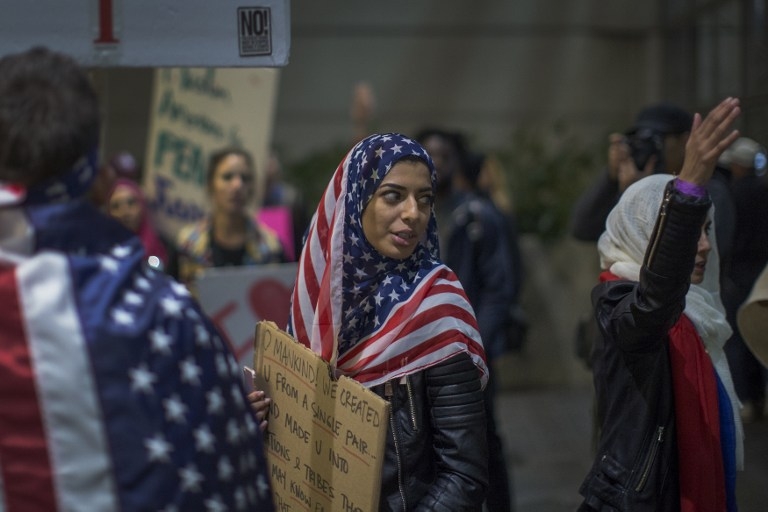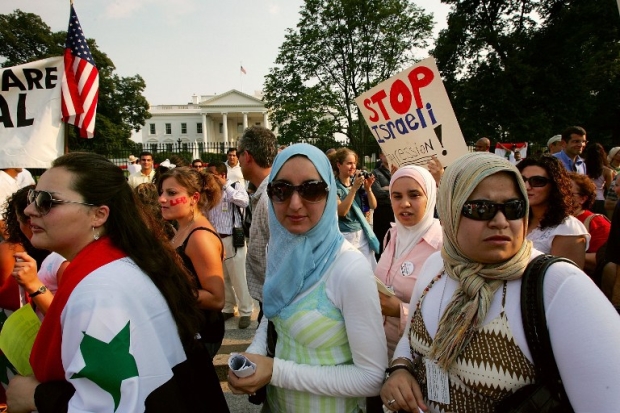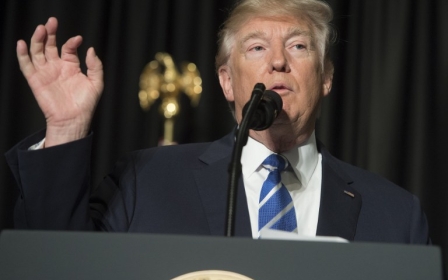American Arabophobia: A settler-colonial disease that started way before Trump's ban

One of the popular signs carried at anti-Trump protests, particularly the ones which erupted after his first executive order banning immigrants and refugees from seven majority-Muslim countries, reads: “First they came for the Muslims, and we said ‘Hell No.’” The sign of course is inspired by the poem attributed to Pastor Niemoller, namely “First they came for the Jews.”
The sign is indicative of mainstream American amnesia, as it erases the fact that “they” (the powers that be, or merely the millions of American racists) first came, and are still coming, for the Native Americans. Then they came, and are still coming, for the African Americans. They also came for the Japanese, and the Chinese before them. And they had also come for the Jews.
Arabs and people who look like Arabs have, while taking flights to and within the US, experienced racial profiling and invasive searches and interrogation for years
Yet the arbitrary starting point of the statement “First they came for the Muslims” somehow voids all American racism prior to Trump’s Muslim ban.
I personally fear and dislike the current president of the US as much as the next pink pussyhat-wearing liberal. But I also believe that we need to come clean about the fact that Arabophobia and Islamophobia were rampant long before him, and were not denounced as loudly - if indeed at all - as they should have been.
Years, not weeks, of discrimination
As many have noted, the seven countries on Trump's immigrant and refugee ban list - all of which, excluding Iraq, are were named on Monday as part of a fresh executive ban - were placed there by his predecessor, Barack Obama, and Obama’s own predecessor, George W Bush, had also waged devastating wars on Arab and Muslim countries.
Arabs and individuals who look like Arabs have, while taking flights to and within the US, experienced racial profiling and invasive searches and interrogation for years, and not just in the past few weeks. Passengers have been kicked off planes for speaking Arabic before 2017.
Jack Shaheen’s Reel Bad Arabs, published in 2001 - but before the 9/11 attacks - documented Hollywood’s consistent depiction of Arabs in some slanderous combination of lecherous, stupid, and violent since the early days of the industry. Steven Salaita’s Anti-Arab Racism in the US was published in 2006, and again, analysed the phenomenon over many years, showing how it had escalated after the 9/11 attacks, but did not spring from them.
This particular brand of hatred is not a new development to be attributed to the Trump administration. And there are few indications that the country would be denouncing Islamophobia and Arabophobia today were it not for the inclusion of Muslims in the list of racialised communities this president has declared open season on. These stretch from North Dakota’s Sioux Nation to the “violent urban centres” to the “bad hombres” and the “rapists” - the latter being a particularly egregious accusation coming from someone who boasts about his uncontrollable urge to sexually assault women.
Sadly, it is safe to assume that if Trump had only “come for the Muslims”, there would not have been widespread protests.
Denying the Arab voice
We cannot - we must not - “forget” our frustration over the past few decades with otherwise “progressive” Americans whose disdain for Arabs and Arab-Americans is engrained in their worldview. The New York Times’ Zionist ideology - and Zionism is Arabophobia par excellence - has long been denounced by Palestinians and their allies, who bristled at the fact that our suffering, our deaths, were never “fit to print".
When Yasser Arafat passed away in 2004, The New York Times published five different opinions about the man and his legacy, not one by an Arab
Our voices, our analysis, our perspectives, were similarly ignored for decades: when Yasser Arafat passed away in 2004, for example, The New York Times published five different opinions about the man and his legacy, not one by an Arab.
This refusal to validate Arab analysis is racism. Similarly offensive approaches have characterised The Nation and the majority of the staff of other progressive publications and television shows.
What is unique about Arabophobia is that it is the one form of American racism that has metastasised since the 1960s, despite the multiple calls for “inclusion” and diversity that came out of the civil rights era. It is also one that is pervasive, if in a “sanitised” form, among liberals who do not question the foundational racism of Zionist ideology, and view Israel as “civilised” and as a democracy.
And while other forms of racism did not dissipate post-civil rights era, Arabophobia is the one that grew virulently after that period, rather than lingered on despite this country’s embrace (even if limited to lip service) of multiculturalism.
When rights are 'national suicide'
Zionism is an essentially racist ideology, as it embraces the privileging of members of one perceived ethnicity over others, whose basic rights are trampled in order to secure the supremacy of a socially-constructed elite. Asher Grunis, then Israel’s chief justice, put it most succinctly when he explained, “Human rights cannot be a prescription for national suicide.”
Zionism has created a simple equation that most Americans, conservative and liberal alike, do not question: Israel is good, Palestinians and their allies, who are critical of Israel, are bad
Zionism has created a simple equation that most Americans, conservative and liberal alike, do not question: Israel is good, Palestinians and their allies, who are critical of Israel, are bad. They are violent, and anti-Semitic. It is the equation of anti-Zionism with anti-Semitism that has long allowed Arabophobia and Islamophobia to go unquestioned amongst a majority of Americans.
Zionism, then, plays a key role in promoting Arabophobia, and we cannot aspire to end Arabophobia without dealing a blow to Zionism. Our task, then, as we challenge the “Muslim ban" is to foreground its connection to Arabophobia and Islamophobia as they are fuelled by Zionism.
Today’s struggle is against policies, a worldview, an ideology, that did not start with Trump. Our fight must be against the cause, not the symptom.
That root cause is multifaceted, and includes hyper-militarism and the country’s addiction to war, along with its history as a settler-colonial nation that funds and grants immunity to the younger settler-colonial kid on the block, Israel.
As more Americans are making the connections between the governments of two countries, the US and Israel, which enact deeply racist and misogynist policies, build walls, ban Muslims, poison and starve people for profit, they are also finding out that fighting Arabophobia is a lost cause when it is not accompanied with the determination to dismantle Zionism.
- Nada Elia is a Diaspora Palestinian writer and political commentator, currently working on her second book, Who You Callin' "Demographic Threat?" Notes from the Global Intifada. A professor of Gender and Global Studies (retired), she is a member of the steering collective of the US Campaign for the Academic and Cultural Boycott of Israel (USACBI)
The views expressed in this article belong to the author and do not necessarily reflect the editorial policy of Middle East Eye.
Photo: On 4 February, demonstrators march in support of a ruling by a federal judge in Seattle that granted a nationwide temporary restraining order against the presidential order to ban travel to the United States from seven Muslim-majority countries, inside the Tom Bradley International Terminal at Los Angeles International Airport (AFP)
New MEE newsletter: Jerusalem Dispatch
Sign up to get the latest insights and analysis on Israel-Palestine, alongside Turkey Unpacked and other MEE newsletters
Middle East Eye delivers independent and unrivalled coverage and analysis of the Middle East, North Africa and beyond. To learn more about republishing this content and the associated fees, please fill out this form. More about MEE can be found here.






